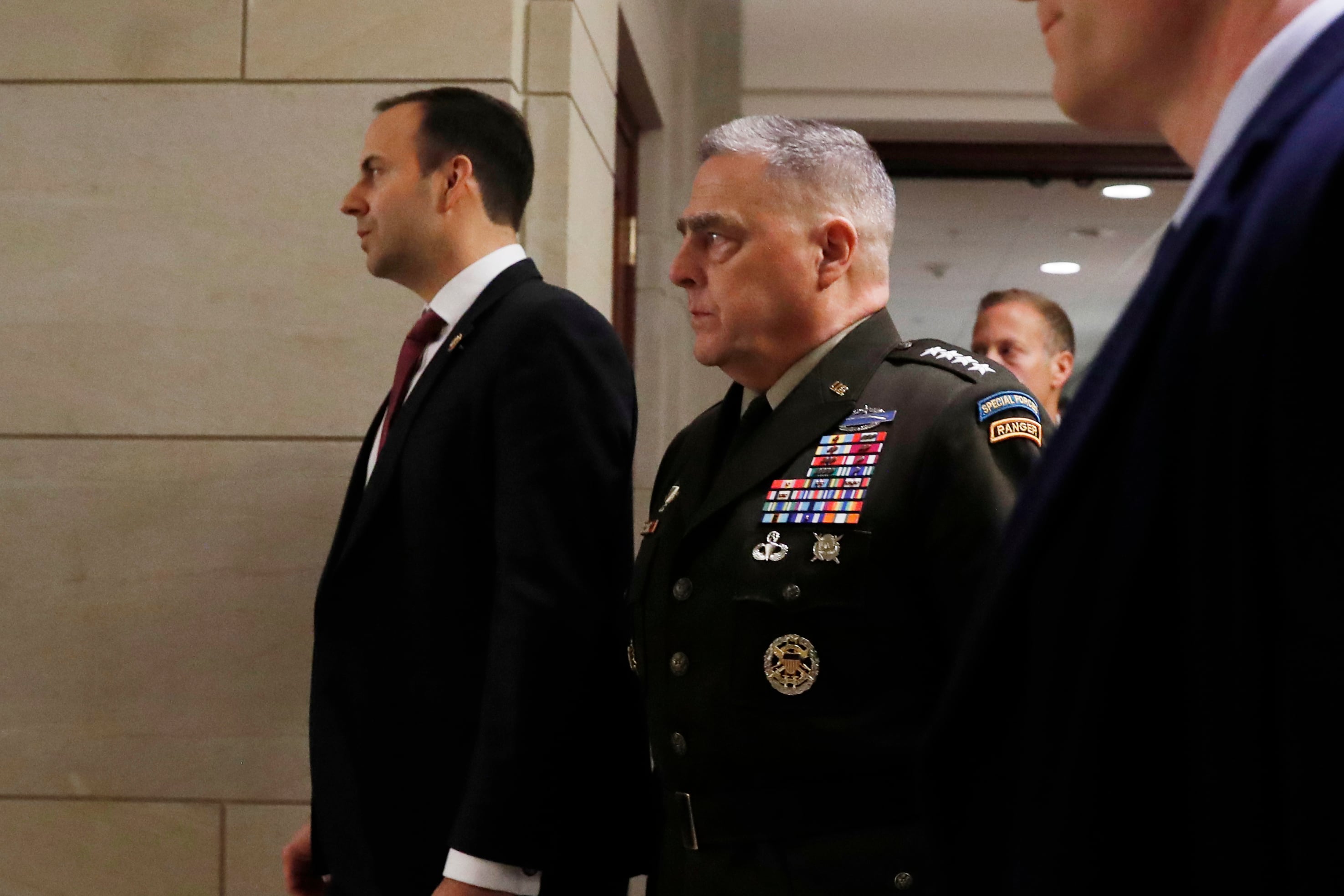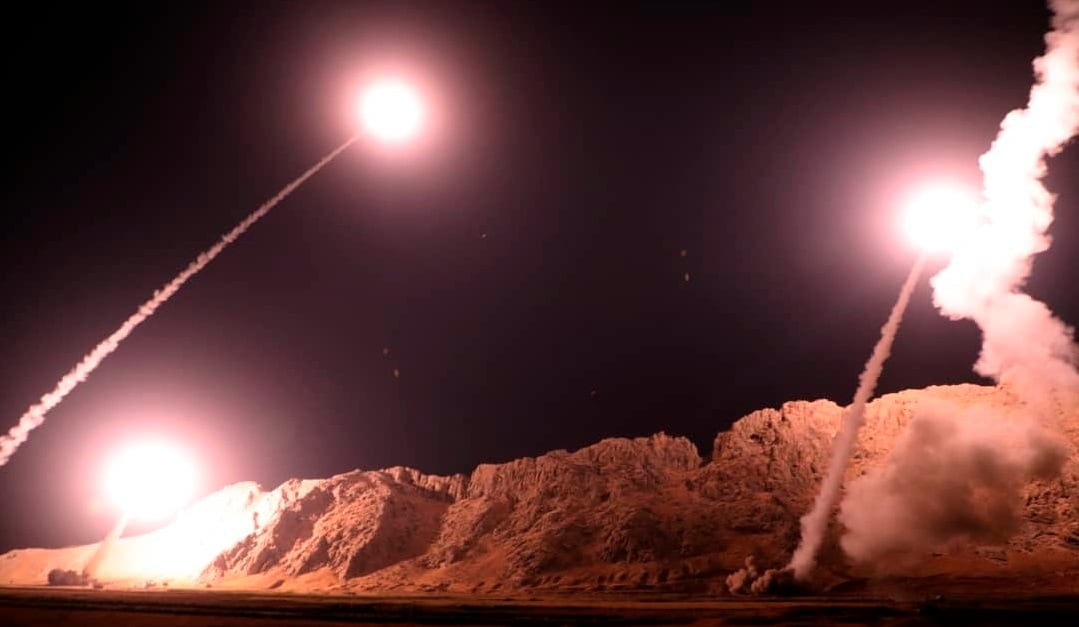The lights went out and darkness set in.
“Second rocket, third rocket came I thought 'This is it, we are getting rocketed.” a U.S. source told Military Times, describing the deadly Dec. 27 rocket attack against an Iraqi military base in Kirkuk that killed an American contractor and wounded four U.S. troops.
Nearly 30 rockets would rain down on the Kirkuk base that houses Iraqi troops, American commandos and U.S. contractors. Army Gen. Mark Milley, the Joint Chiefs chairman, would later go on to describe the Iran-sponsored attack as an intent to “kill American soldiers sailors, airmen and Marines…. 31 rockets aren’t designed as a warning shot.”
“When there was that silence after the rockets, the personnel around me got together to run towards the bunkers. That’s when we saw the armory was on fire,” the U.S. source told Military Times, recounting the Kirkuk attack.
The armory was set ablaze after a 107 mm rocket hit a T-Wall causing the concrete to break off that then sparked an electrical fire. A video of the incident, provided to Military Times, shows the armory on fire — secondary explosions can be heard in the background as rockets and ammunition cook off.
The source told Military Times that some people manned various positions while others sheltered in bunkers.
“It’s one thing to send rounds down range, but to be on the receiving end is something you cant imagine unless you have been there. Especially when you build a coffin for your fallen comrade out of plywood and 2x4s,” the source said.
The source told Military Times that the base is bracing for more attacks, but the source would not elaborate any further due to operational security concerns.
“It’s our job out here. We drink our Ripits and muscle milk, go to the gym, shit, shower, shave, and hope they attack again so we can smoke their ass,” the source said.
U.S. officials fingered an Iran-backed group known as Kata-ib Hezbollah for the deadly strike that killed a U.S. contractor, identified by the Sacramento Bee as Nawres Waleed Hamid, a resident of California.
The Kirkuk attack set of a series of escalatory events leading to a U.S. airstrike against the Iran-backed militia, the near storming of the U.S. Embassy in Baghdad, a decapitation strike that killed Iran’s most capable field commander, Qassem Soleimani, and a retaliatory ballistic missile launch by Iran.
RELATED

Backed into a corner by simplistic rocket attacks carried out by rag-tag Iraqi militia groups in beat-up pickups boasting concealed makeshift rails for launching 107 mm rounds — the U.S. responded with force, holding Iran responsible for the attacks against coalition troops, without providing any evidence of Iran or the militia group’s culpability.
Rocket and indirect fire attacks in Iraq have been a relatively common occurrence since American armored vehicles and troops toppled Saddam Hussein in 2003. Any veteran of the Iraq conflict can tell you mortars and rockets are just another day in Iraq.
But since October, U.S. officials have peddled a near weekly roll-up of the number of rocket attacks allegedly carried out by Iran-backed Iraqi militias that fall under the Popular Mobilization Forces’ banner. PMFs are an umbrella organization of predominantly Shia Iraqi militias.
U.S. officials have complained to the Iraqi government of the PMF’s direct connections and cozy relationship with Iran’s Islamic Revolutionary Forces Guard Corps, but Iraq has struggled to rein in the militia groups.
Coalition forces have yet to respond to Military Times’ questions about the latest rocket attack against Baghdad’s Green Zone, but a news release from the U.S. State Department on Wednesday noted there have now been 14 rocket attacks against U.S. and American interests in Iraq since September — the rocket attack count gambit continues unabated.
Following the Jan. 2 U.S. strike that killed Soleimani and Iraqi Hezbollah leader Abu Mahdi al-Muhandis, PMF chatter across social media exploded with calls for revenge attacks against U.S. troops and for martyrs to join the ranks of the militia.
Baghdad’s Green Zone was rocketed on Jan. 4 and Jan. 5 as Iraqis began a funeral procession for the slain Iranian commander and Iraqi PMF leader.
Another U.S. source on the ground in Baghdad told Military Times that the Green Zone rocket strikes appeared to be more severe than the usual scare tactics. The source said that the volley of fire seemed to have increased and that the embassy was hit hard.
The source explained that rocket attacks often missed to scare people, now rockets are impacting the American diplomatic compound.
Tensions between Tehran and Washington were on the brink when Iran launched 16 ballistic missiles against two Iraqi bases housing U.S. troops at al-Asad and Irbil. Iran’s strike was a response to America’s strike that killed Soleimani.
As Iranian ballistic missiles fell from the sky, an American commando in Irbil told Military Times a missile “apparently hit just off the airfield in Irbil and Asad is getting punished,” the source said. “Waves coming in five-minute intervals of 4-5 missiles at the airfield.”
RELATED

“But we knew immediately it was coming from Iran," the source detailed.
The U.S. source said that nonessential personnel hunkered in bunkers while some of the leadership got into full battle rattle with kit and helmet and manned an operations center.
The American commando said the day following the attack everything was backed to normal.
“I am still fucked up from everything,” the source said. The source further explained that it was mostly the sleep deprivation that was messing with him. “The missile launch was just a bonus,” the source said.
Defense Secretary Mark Esper told reporters at the Pentagon Wednesday that 11 missiles struck al-Asad, one hit Irbil and four missiles failed in flight. The missiles, Esper said, were launched from three sites in Iran.
The Iraqi government claims that Iran launched 22 missiles.
Esper detailed that damage included runways, taxiways and a helicopter. A U.S. defense official confirmed to Military Times that the helicopter damages in the Iran strike was an American asset.
Despite the most recent rocket attack in Baghdad, Iran and the U.S. appear to be pulling back from the brink of a larger military confrontation.
President Donald Trump said Wednesday that Iran appeared to be “standing down” following the ballistic missile strike, but he warned of sanctions and military retaliation if it continued its malign behavior.
“Peace and stability cannot prevail in the Middle East as long as Iran continues to foment violence, unrest, hatred and war,” Trump said at the White House on Wednesday.
But worries still persist that Iran-backed militias orchestrating attacks could push the U.S. into a broader conflict with Iran. Some Iraqi nationalist groups could take matters into their own hands to foment a war between Tehran and the U.S. Hours after the president spoke, Iraqi security forces said two Katyusha rockets landed in Baghdad’s Green Zone, with no reported casualties.
For now, U.S. officials are still counting rocket attacks against coalition interests in Iraq.
Esper told reporters Wednesday that Iran-backed militias in Iraq will “remain a challenge” to “sort through." The U.S. will need to be able to separate the the militias and Iran and their activities and see “who’s doing it and who’s motivating it," Esper said.
Militia activity will continue in some “shape or form” to try and “undermine our presence there [Iraq],” Esper told reporters at the Pentagon Wednesday.
Shawn Snow is the senior reporter for Marine Corps Times and a Marine Corps veteran.



